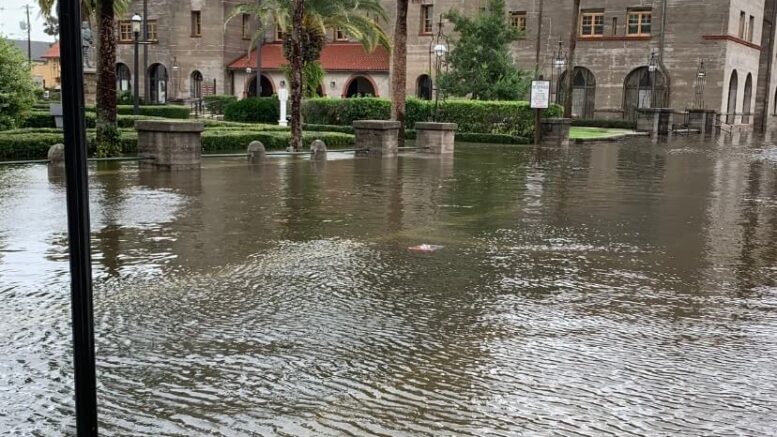By Megan Churchill
Flooding in St. Augustine is something all residents are familiar with. College students wading through foot-high water as they walk down Granada Street is a common scene near Flagler’s Campus. Downtown St. Augustine business owners are used to rivers of rainwater running past their shops.
The city’s streets flood roughly 10 times a year, according to an article published by jacksonville.com. The repercussions of intense flooding can be disastrous.
St. Augustine residents Mark and Margo Alexander were left with damage after Hurricane Matthew brought water 4 feet high within their home in 2016.
“You could stand in one side of our house and see the whole house … We were starting over again, basically,” Mark Alexander said.
They tore out what was left of the interior of their home and rebuilt it.
To begin looking into solutions for the regular flooding, the U.S. Army Corps of Engineers and the city of St. Augustine have begun collaborating on the St. Augustine Back Bay Feasibility Study.
The study is an $8 million project that is looking into ways to protect the city as the climate changes and the threat of flooding increases.
According to the Army Corps Website, “a feasibility study is the first step toward a potential federally-cost shared water resources project.” The website states that the study, “could be one piece of the City of St. Augustine’s overall, long-range flood resiliency strategy.”
This flood resiliency strategy is important because so many St. Augustine residents are at risk of their homes flooding.
Projected to be completed in 2028, the Back Bay Feasibility Study will analyze how to combat flooding in the entirety of St. Augustine: 17 distinct neighborhoods and different bodies of water including the San Sebastian River, The Matanzas River, and the St. Augustine Inlet.
The study will look into what barriers to flooding can be put in place: things like storm surge gates and increased sand dunes, but also mangroves and oyster beds are options to be analyzed.
The result of the study will be a document which recommends, “a coordinated and implemented solution for hurricane protection, storm damage reduction, beach erosion control, and other related purposes at St. Augustine, Florida,” according to the U.S. Army Corps Website.
Flagler College Science Professor and City Commissioner Barbara Blonder spoke of the importance of the study, saying because of the repercussions of climate change it’s more critical than ever that some form of action is taken.
“It’s not just sea level rise … it’s also rainfall,” Blonder said.
Blonder said one of the causes of the increasing rainfall is climate change.
“The atmosphere holds more water with the increasing temperatures and the storms are moving more slowly, so they just sit on top of us and dump rain,” Blonder said.

There are different ways of handling the increasing amount of flooding the city has been experiencing.
Blonder said natural infrastructure — also known as green infrastructure — should be looked at as an option when it can be. Gray infrastructure includes things like storm surge gates, while green infrastructure is focused on utilizing natural resources like planting mangroves, and oyster beds.
“The green infrastructure provides the ecosystem services that are not directly related to flooding, whether it’s storage of carbon and production of oxygen or whether it’s habitat for different species,” Blonder said. “There’s just a multitude of different ecosystem services that are provided by green infrastructure that are not by gray infrastructure.”
She said the locations in St. Augustine are variable in what type of infrastructure will be adequate for the task.
“Davis Shores might be very different from West Augustine, might be very different from North City, and all of these areas flood and have challenges, but they’re all a little bit different,” Blonder said.
Earlier this fall, representatives from the Army Corps and the city of St. Augustine held a meeting in which all St. Augustine residents were invited to share ideas as to what form of storm prevention would work best in their area of the city.
St. Augustine residents Steve Arflin and Patrick Crocetta, who attended the meeting, have experienced flooding issues firsthand.
Arflin, who lives in the Fullerwood neighborhood just north of the Florida School for the Deaf and the Blind, said his house has flooded twice in recent hurricanes.
Crocetta lives on St. George Street near Lake Maria Sanchez and has had similar experiences.
“The last time when we had serious flooding was last fall, we had two serious hurricanes [Hurricane Ian and Hurricane Nicole],” Crocetta said. “We had 18 inches of water on our property on one storm, and we had 15 inches on the other storm.”
St. Augustine residents attending the meeting in October, said they’re happy some form of action is being taken now. Up until now residents have been left with few options and little access to resources.
“We’ve applied for the grant to raise our home, but that’s kind of like winning the Florida Lottery – it’s that hard to get you know,” said downtown resident Margo Alexander.
The Alexanders said seeing grant money come to the town of St. Augustine in general would make them happy, as they know there are many families in need of it.



Be the first to comment on "Back bay feasibility study: combatting frequent flooding in St. Augustine"